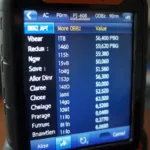OBD2 starter code refers to using an OBD2 scanner to diagnose and sometimes even control a vehicle’s starting system. This involves accessing specific diagnostic trouble codes (DTCs) related to the starter motor, solenoid, relay, and associated wiring. Having this access can be invaluable in troubleshooting starting issues and preventing costly repairs. Let’s delve deeper into the world of OBD2 and its role in diagnosing starter problems. For a closer look at how OBD2 can be used for starting, check out can a obd2 start engine.
How OBD2 Helps Diagnose Starter Problems
An OBD2 scanner can be a powerful tool when your car won’t start. By reading the DTCs stored in the vehicle’s computer, you can quickly pinpoint potential issues within the starting system. While an OBD2 scanner might not directly tell you “starter motor failure,” it can point to related problems like low voltage to the starter, a faulty relay, or issues with the immobilizer system. This information can save you time and money by guiding you towards the correct repair.
One common scenario is a clicking sound when you try to start your car. This could indicate a failing starter solenoid or a weak battery. An OBD2 scanner can help confirm if the battery voltage is low, providing valuable insight. Another example is when the engine cranks but doesn’t start. While this might indicate a fuel or ignition problem, a related DTC could reveal a faulty crankshaft position sensor, which indirectly affects the starting process.
Different scanners offer varying levels of functionality. Some basic code readers only display the DTCs, while more advanced scan tools can provide live data streams, allowing you to monitor the voltage supplied to the starter during the starting process. This can be extremely helpful in pinpointing intermittent issues.
Common OBD2 Starter Codes and Their Meaning
Understanding specific DTCs related to the starting system can be crucial. However, remember that not all starting problems will generate an OBD2 code. Some issues are purely mechanical and require physical inspection.
Some common codes that might indirectly indicate a starting problem include:
- P0335: Crankshaft Position Sensor A Circuit Malfunction
- P0336: Crankshaft Position Sensor A Circuit Range/Performance
- B1421/B1422: Immobilizer System Malfunction
- U0100: Lost Communication With ECM/PCM
These codes might not directly point to the starter, but they can impact the starting process. If you encounter these codes, it’s important to investigate further to determine the root cause.
 Common OBD2 Starter Codes and Meanings
Common OBD2 Starter Codes and Meanings
You might also find using a scan tool bluetooth obd2 helpful for convenience.
Beyond Diagnostics: Using OBD2 for Starter Control
Some advanced OBD2 scan tools and software allow for limited control over vehicle systems, including the starter. While this is not a common feature, it can be useful for testing purposes. However, it’s important to exercise caution when using this functionality, as improper use can potentially damage the starter or other components.
What if there’s no OBD2 Starter Code?
If you’re having starting issues but your OBD2 scanner isn’t showing any relevant codes, there are several other things to check. These include the battery, starter solenoid, starter relay, and wiring. Physical inspection is often necessary. Check out our article on obd2 car engine starter for more information.
You can also check out check car battery health via obd2 for a more in-depth guide on this topic. This includes using the OBD2 scanner to monitor battery voltage during the starting process.
Using the ldex bluetooth diagnostic scanner obd2 can simplify the diagnostic process.
Conclusion
Understanding and utilizing OBD2 starter code can be a valuable asset in diagnosing and troubleshooting starting problems in your vehicle. While the OBD2 system might not always directly identify a faulty starter, it can offer valuable clues that can lead you to the root cause of the issue. Remember that an OBD2 scanner is just one tool in your diagnostic arsenal, and a thorough understanding of your vehicle’s starting system is essential for effective troubleshooting. By combining OBD2 diagnostics with physical inspection, you can quickly resolve starting problems and get back on the road.
FAQ
- Can an OBD2 scanner start my car? While some advanced tools offer limited starter control, this is not a primary function.
- What does it mean if I don’t get any OBD2 starter codes? This might indicate a mechanical issue requiring physical inspection.
- How can I check my battery health with an OBD2 scanner? You can monitor battery voltage during the starting process using live data.
- What is a common OBD2 code related to starting problems? P0335, related to the crankshaft position sensor, can sometimes cause starting issues.
- Can I use any OBD2 scanner to diagnose starter problems? Yes, most scanners can read relevant DTCs, although advanced scanners offer more functionality.
- What is the difference between a starter code reader and a scan tool? Code readers only display DTCs, while scan tools offer more advanced features like live data.
- What should I do if my car clicks but won’t start? This could indicate a bad starter solenoid or a weak battery. An OBD2 scanner can help confirm low voltage.
Need further assistance? Contact us via WhatsApp: +1(641)206-8880, Email: [email protected] or visit us at 789 Elm Street, San Francisco, CA 94102, USA. We have a 24/7 customer support team ready to help.
